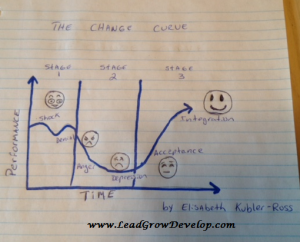The marketplace is becoming more and more aggressive. In order to remain competitive, what was once “Great” yesterday may only be considered “Good” today. Companies must adapt to the changing market on an ongoing basis. As companies change, employees find themselves having to learn new skills and eliminate old habits. They may even get that understandable feeling that they “have to start over”.
As you may know, I am a District Manager for a Retailer. Retail is a perfect example of an industry that is in constant change. Those who don’t anticipate market needs and change accordingly, don’t last. In the last 12 months, there have been executive changes 4 levels deep, 3 levels deep just in the last 4 months.
My boss…
my boss’ boss …
and my boss’ boss’ boss, have all been changed recently.
In fact, at the time this post will publish, Monday, it will be my new boss’ first day.
With change, comes natural reactions such as hesitation, fear, frustration, curiosity and more. We fear change at work for a variety of reasons. These fears are often associated with fear of failure, fear of success, fear of rejection, fear of criticism and fear of the unknown. Fear…Fear…Fear
In the 1960s Elisabeth Kubler-Ross developed, “The Change Curve” to explain the grieving process. Since then it has been widely utilized as a method of helping people understand their reactions to significant change or upheaval. My current employer even did a training segment for all DSMs on this “Change Curve”.
The Change Curve depicts the 6 stages that a person may go through in adapting to change: Shock, Denial, Anger, Depression, Acceptance, and Integration. One person may be stuck in one stage longer than another, or skip a stage or stages altogether. For example, when faced with a change, you may first experience shock, then go straight through to acceptance and integration. As a leader, how can you help your team manage change? How can you manage change yourself?
Here Are 10 Tips For Dealing With Change In The Workplace
Dealing with Change Yourself:
Recognize that Change Does Happen
Realize that progress is impossible without change. Change cannot be avoided. The first step in dealing with change is in managing your expectations and knowing that change is a needed necessity. Be ready for it.
Be Aware of Your Surroundings
Stage 1 in the “Change Curve” is Shock. Change is hardest when it is not expected. Be aware of your surroundings and plan for the change that is necessary.
Companies that fail to react to change, especially technological innovations like saas management tools, are the first to fall behind.
Be Flexible
The harder you push and resist change, the harder it will be for you to accept necessary change. Instead of spending energy on trying to avoid it, or complain about it, try to see “the Big Picture”. Understand the “Why” and its benefits.
[tweetthis]If you don’t like something change it. If you can’t, change your attitude. — Maya Angelou[/tweetthis]
Do A Self-Assessment
Sometimes the company you are working for evolves and adapts to new demands faster than the team that works for them. What new skills do you need to learn to help your company succeed? Take a moment to do a self-assessment and review your development plan. Is there anything that you now need to focus on that was not a necessity before?
Replace Fearful Thoughts with Something Positive
Are you having some fearful thoughts yourself? Are you hesitant and unsure that you can be successful in a new environment? Earlier I gave an example of my Director of Operations being new. I can choose to nurture any fearful thoughts that may arise; “Will I have to start over? Will her leadership style help or deter my professional development? Will she be a Micro-Manager?
Or I may look at the positive and realize that with every new leader, there is always something new to learn. I can also look at it as a new challenge, instead of a negative situation.
Emotional Intelligence
One of the best ways you can deal with change, or any obstacle, is by working on enhancing your emotional intelligence. Emotional Intelligence is being aware that emotions can drive our behavior and impact people (positively and negatively). It is about learning and enhancing our ability to manage those emotions – both our own and others – especially when we are under pressure. Focusing on developing your emotional intelligence can make all the difference in how far you want to take your career, and even in how you achieve your personal goals.
Dealing with Change as a Leader:
Recognize the Stages
If you are responsible for leading a workplace change, as a leader, you need to recognize stages of the “change curve” that your team might be on. It is unrealistic to expect acceptance and integration from your team immediately. Be there to help guide them through the stages as quickly and seamless as possible.
Communicate with Others
One way to conquer the fear of the unknown is through the acquirement of knowledge. Maintain open communication in order to answer any questions that your team may have. Before communicating the upcoming change to your team, try to get all the answers to your own questions. Be comfortable with the ins and outs of the change as much as possible before communicating it to others.
Be Positive in Actions and Attitudes
Sometimes as a leader, you may still be in the beginning stages of “the change curve”. Your team is looking to you for support. Ensure that through your communication and actions, you are supporting the necessary changes that your company needs to go through.
Be Part of the Change
One great way you can adapt to change is to become part of it. Create a plan for how you can achieve success in this new situation. Be an influencer and driver of change.
What type of changes have you had to adapt to recently?
